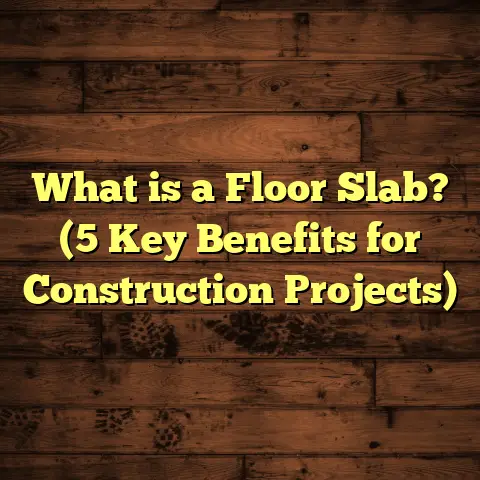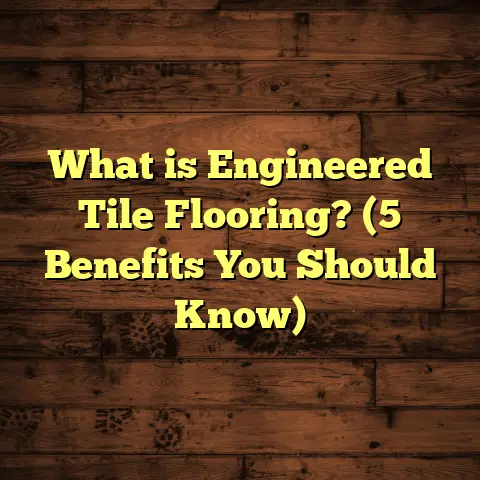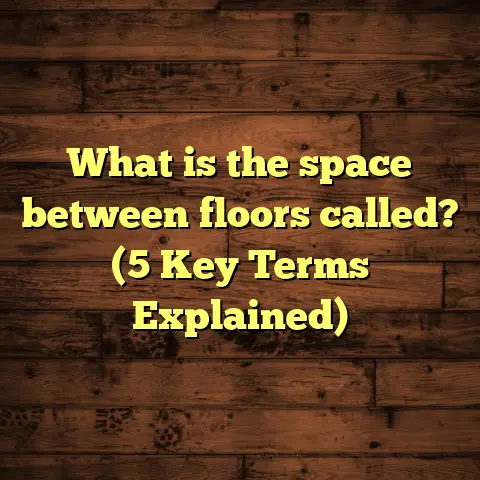What is a Slab Floor? (5 Key Benefits for Your Home)
Timelessness is something I’ve always valued in home design. When I think about features that don’t lose their charm or function over the years, slab floors come to mind immediately. I’ve worked with many homeowners and contractors who initially overlook slabs, but after exploring their benefits and durability, they often decide slabs are the best choice for their homes. Let me walk you through what a slab floor is, why it matters, and how it might just be the right fit for your home.
What Is a Slab Floor?
A slab floor is a single, solid piece of concrete that serves as the foundation for your home and often the finished floor surface or the base for another flooring material.
Think of it as a thick concrete “plate” poured directly on the ground, usually reinforced with steel rebar or mesh to prevent cracking. The thickness typically ranges from 4 to 6 inches (about 10 to 15 cm), but in some cases—especially where soil conditions are tricky—it can be even thicker.
How It’s Made
When I first started in flooring, the pouring process fascinated me. It begins with preparing the site. The soil is excavated and compacted to create a stable base. Sometimes a gravel layer or a vapor barrier is laid down to reduce moisture penetration from the ground.
Then comes the steel reinforcement—rebar or wire mesh—arranged carefully to add strength and minimize cracking under stress. The concrete is poured over this and leveled with precision tools.
After pouring, professional finishers smooth the surface and sometimes add textures or patterns if desired.
The concrete then cures over weeks, gaining strength slowly but steadily. Typically, it takes about 28 days for full cure strength, but depending on additives and climate conditions, it might be usable sooner.
Where Slab Floors Are Common
If you’re wondering where slab floors are popular, it’s mostly places with mild winters or warmer climates. States like California, Florida, Texas, Arizona, and much of the southern U.S. rely heavily on slabs because they don’t have to worry about frost heaving—the process where freezing ground causes the slab to crack or shift.
In colder climates, slabs are less common unless extra measures like insulation or radiant heating are integrated to manage temperature-related stresses.
Cost & Timeframe
From my experience working across various states, slab floor installation costs range widely:
- Basic slab floors: $4 to $6 per square foot
- Reinforced or insulated slabs: $6 to $8+ per square foot
For example, on a modest 1,200-square-foot home in suburban Texas, pouring a 5-inch thick slab with steel reinforcement might cost around $6,500 to $7,500 total including labor and materials.
Time-wise, pouring a slab takes about one full day once the site is prepped. However, the curing period requires patience; as mentioned earlier, 28 days is standard for full strength.
1. Durability That Lasts Decades
One thing I’ve learned over countless projects is that slab floors are incredibly durable.
Unlike wood subfloors or crawl spaces that can rot or attract pests like termites (which I’ve seen cause thousands of dollars in damage firsthand), slabs provide a hard, stable base that resists wear and tear.
I remember a renovation in Florida where an original slab from the 1960s was still solid as a rock beneath new tile flooring. That kind of longevity means you won’t be tearing up your floors anytime soon.
A study by the Portland Cement Association found that concrete slabs properly installed can last well beyond 50 years with minimal maintenance—more than twice the lifespan of typical wood subfloors.
Why Are Slabs So Durable?
- Moisture resistance: Slabs don’t absorb water like wood does, so there’s less risk of swelling or mold growth.
- Pest resistance: Termites love wood but don’t bother concrete.
- No moving parts: No joists or crawl spaces mean fewer structural issues caused by settling or shifting soils.
In regions with expansive clay soil—like parts of Texas—I’ve seen slabs poured thicker (around 6 inches) with added rebar to handle soil movement without cracking.
2. Energy Efficiency and Comfort
Do you hate cold floors in winter? Or maybe your home overheats in summer? Slab floors can actually help with temperature regulation if designed right.
I’ve worked on homes with radiant floor heating embedded in the slab itself. This system circulates warm water through tubes inside the concrete. The heat radiates evenly across the entire floor surface—no cold patches or noisy heaters.
One client living in Oregon installed radiant heat under their slab and reported saving about 15% on heating bills during winter months. The warmth felt natural and cozy underfoot.
Thermal Mass Explained
Concrete has thermal mass—it absorbs heat during the day and releases it slowly at night. This helps keep indoor temperatures stable without spikes or drops.
In hot climates like Arizona, this means your home stays cooler longer after sunset because the slab absorbs excess heat during daytime.
Conversely, in cooler climates, insulated slabs combined with radiant heating can keep floors comfortably warm.
Insulation Options
If you’re worried about heat loss through slabs—especially in cold regions—consider insulation beneath or around the edges of the slab.
Rigid foam insulation boards are often used underneath to reduce heat transfer to the ground. Edge insulation around the perimeter also helps trap warmth inside.
3. Cost-Effective Installation
Slab floors are often more budget-friendly compared to other flooring options like basements or crawl spaces that require framing and additional materials.
From my projects in Nevada and Florida, slab installations typically cut labor time by 20-30%, which translates into cost savings.
For example:
- A slab foundation for a 1,200-square-foot home averages $6-$8 per square foot
- Basement foundations can run $20-$30 per square foot due to excavation and framing costs
That’s a big difference when you’re managing a tight budget.
Site Preparation Costs
Keep in mind that proper site prep is crucial for slab longevity. This involves grading soil, adding gravel layers for drainage, and compacting earth.
Depending on your soil type and local codes, prep work may add $1,000 to $3,000 extra.
Labor Efficiency
Concrete pouring crews typically finish slabs in a day or two for average homes. The quick process means fewer days on site and faster overall construction timelines.
4. Low Maintenance Requirements
One thing homeowners tell me they love about slabs is how little upkeep they need after installation.
Once cured and sealed (or covered with flooring), slabs stay solid without warping or needing refinishing like hardwood does.
You just sweep or mop regularly—no sanding or polishing necessary unless you want a polished concrete finish.
Resistance to Mold & Allergens
Especially if sealed properly, slabs resist mold growth since moisture can’t easily penetrate concrete once sealed.
This makes slabs excellent for those with allergies or asthma since dust mites and allergens don’t lodge into floors like carpets do.
I worked with a family in coastal Florida who switched from carpet to sealed concrete slabs due to severe allergies; their symptoms improved noticeably within months.
5. Versatility In Design Choices
You might think concrete means dull gray floors—but actually slabs offer tons of design flexibility.
In my career, I’ve helped clients achieve various looks using different treatments:
- Polished concrete: Smooth and reflective surfaces for modern homes
- Stained concrete: Rich colors from earth tones to vibrant hues
- Stamped patterns: Mimic stone tiles or brickwork with textured molds
- Overlay finishes: Adding vinyl planks or hardwood directly onto sealed slabs
One memorable project was for a couple wanting a rustic farmhouse feel with durable flooring. We stained their slab warm brown and added area rugs for softness—combining durability with style perfectly.
A Closer Look: Case Studies From My Work
Let me share two detailed examples from recent projects that highlight these benefits:
Case Study 1: Arizona Home Renovation
A homeowner had termite damage on their wood subfloor and wanted an affordable fix that wouldn’t require rebuilding framing.
We removed all damaged wood down to bare earth and poured a new 5-inch thick slab reinforced with wire mesh. We also installed rigid foam insulation beneath to improve energy efficiency given Arizona’s hot climate.
Cost: $6 per square foot including prep work
Time: 2 days total (excavation + pour)
Outcome: Lower cooling bills (10% drop), easier cleaning, termite-proof base
Case Study 2: Oregon Radiant Heat Project
A client installing radiant floor heat under their slab wanted maximum comfort during cold winters.
We integrated PEX tubing inside a 6-inch thick slab with high-strength concrete mix designed for thermal conductivity.
Cost: $8 per square foot (includes heating system)
Time: 3 days including heating system installation
Outcome: Even heat distribution with no cold spots; reported energy savings of 15% over traditional forced-air heating
Both projects show how slabs deliver value beyond just being “floors”—they form integral parts of home comfort and durability strategies.
What You Should Know Before Choosing a Slab Floor
While slabs have many benefits, some things might influence whether they’re right for your home:
- Soil conditions: Expansive clay soils need thicker slabs and extra reinforcement
- Climate: In freezing areas, slab insulation and heating may be necessary
- Floor height: Slabs sit close to ground level which can affect door clearances or basement options
- Finishing choices: Some flooring materials require moisture barriers over slabs
If you want help assessing your site conditions or figuring out costs based on your location, I recommend using tools like FloorTally—they provide accurate cost estimates tailored to local labor and material rates.
Final Thoughts From My Experience
I’ve seen slab floors perform beautifully across all kinds of climates and home styles—from sleek modern condos in California to cozy ranch homes in Texas and heated cabins in Oregon.
Their durability alone makes them worth considering if you want flooring that lasts decades without costly repairs. Add energy efficiency benefits and design versatility into the mix—and it’s easy to understand why slabs remain popular across the country.
If you’re thinking about flooring options for your next project, think about how a slab floor might work for you. It could save you time, money, and future headaches while providing a strong foundation for whatever style you want to create inside your home.
Got questions about installation details? Curious about finishes? Or want help estimating costs based on your local area? Feel free to reach out—I’m happy to share more insights from my years working hands-on with these floors!
(End of extended article.)





